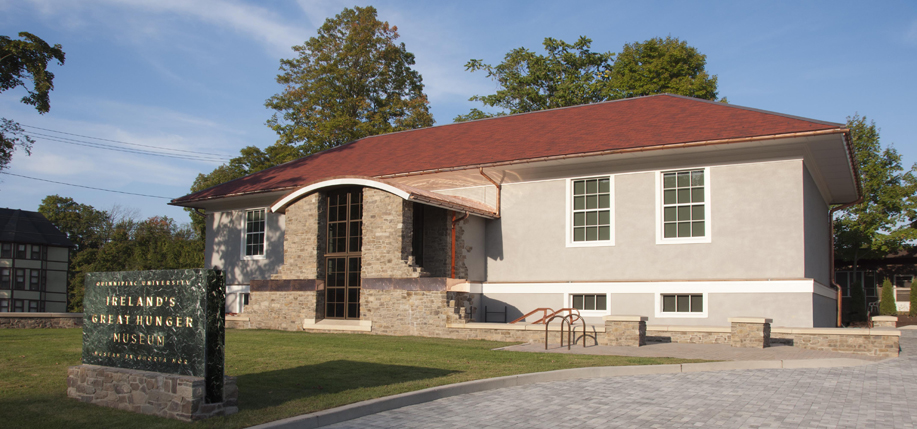The first Irish Famine museum in the U.S. was dedicated in Hamden, CT on September 28.
Under the leadership of its president, Dr. John L. Lahey, since 1997 Quinnipiac University has been amassing a collection of art, texts and artifacts related to the the Great Hunger. The museum, at 3011Whitney Avenue, between the university’s Mount Carmel and York Hill campuses, is now the permanent home of the collection – one of the largest in the world. In particular, the collection focuses on the worst of the famine years, 1845-52, when blight destroyed Ireland’s potato crops, bringing about drastic social and human rights consequences that would, between deaths and immigration, cut the Irish population in half and forever change the course of Ireland’s history.
Niamh O’Sullivan, professor emeritus of visual culture at the National College of Art and Design in Dublin, served as the museum’s inaugural curator. The ground floor contains an informational video about the famine and the collection’s 19th and early 20th century pieces, including works by Daniel MacDonald, James Arthur O’Connor and Jack B. Yeats.
The second floor exhibits more modern pieces, such as a replica of John Behan’s famous famine ship sculpture that sits at the base of Croagh Patrick, Rowan Gillespie’s moving sculptures, and a stunning floor-to-ceiling painting by the late Micheal Farrell of a surreal courtroom scene with William Trevelyan.
Before the dedication, Mick Moloney and the Green Fields of America gave a special concert at Quinnipiac’s School of Law Center. Then, over 200 people gathered on the second floor of the 4,750-square-foot museum to witness the dedication.
Speakers included President Lahey; Leo Varadkar, Ireland’s Minister for Transport, Tourism and Sport; Connecticut senator Richard Blumenthal, Niamh O’Sullivan, Consul General Noel Kilkenny; and historian Christine Kinealy, whose book This Great Calamity Lahey credits with sparking his interest in the famine. “Famine,” she said, “is not the work of Mother Nature, but of the inequalities created between men.”
President Lahey spoke of the museums journey into existence, which started during his time as grand marshal of the NYC St. Patrick’s Day Parade in 1997. Asked to talk at countless Irish events, he chose to use the platform to speak out about the famine, which was still at that point a somewhat neglected and misunderstood chapter in Irish history.
Today we know it to be one of the most tragic, with the deaths of over 1 million Irish men, women and children, but also one of the most seminal – a time when over 2 million Irish emigrated to England, the US and beyond, casting the wide net of the diaspora.
The Ireland’s Great Hunger Museum is an important testament to all this, and will be an invaluable tool for teaching and spreading awareness about the famine’s significance, complexities and lingering influence.
“The museum will preserve, build, and present its art collection in order to stimulate reflection, inspire imagination, and advance awareness of Ireland’s Great Hunger and its long aftermath on both sides of the Atlantic,” said President Lahey.
He also commented on the appropriateness of the museum’s location – right between the Irish American hubs of New York and Boston.
Dignitaries included First Lady of Connecticut Cathy Malloy and many of artists, including Robert Ballagh, Alanna O’Kelly, and John Behan. Gilly Lenders, the widow of Murray Lenders, the Quinnipiac alum and trustee whose passion and generosity made the museum possible, was also present.
Following the dedication ceremony, attendees and Quinnipiac students were treated to an evening of Irish entertainment. The Dropkick Murphys, Black 47 and The Pilatzke Brothers and Cara Butler performed at the university’s TD Bank Sports Center.
As of Oct. 11, the museum will be open to the public Wednesdays 10 a.m.-5 p.m.; Thursdays 10 a.m.-7 p.m.; Fridays and Saturdays 10 a.m.-5 p.m.; and Sundays 1-5 p.m. Admission is free. The museum is located at 3011 Whitney Avenue, near Quinnipiac University’s Mount Carmel and York Hill campuses.
See photos from the dedication:











Congratulations on the opening of the Museum which I hope tells the truth about the Great Hunger in Ireland in the 1840’s.
We know it was not a famine but a starvation of a people when there was plenty of food but kept from the Irish.
I hope you have many visitors to see the truth.
Maybe I’ll get there some day from Michigan.
I was so pleased to recently hear of your museum and pray blessings to your endeavor.
I would like to make sure you have knowledge of ships of Irish immigrants who were not allowed to enter NYC because of sickness on board. They were taken down the St Lawrence Seaway to an island near Quebec City. As I recall there is a mass grave of 5000 Irish on this island with a large celtic cross . Perhaps 10000 Irish orphans among these orphans was Henry Ford’s grandfather. – and some of my relatives. My grandmother recalls hearing of her ancestor jumping ship in the St Lawrence with a baby strapped to her back. When she got to
the shore the baby was gone. There is a website for this place – Gross Island, Quebec.
I live in Georgia but hope to visit your museum one day.
Sincerely,
Fern Roberson
Hallowed Ground of Irish Famine Victims
Grosse Ile, on the Saint Lawrence Seaway, near Quebec City, was the site where Irish victims of the ;( Famine of the mid 1800s were quarantined. Many of whom never got to see the Canadian mainland. Mass graves and a monument honoring those who perished are in evidence on the little island.
Hi
I am a gallery owner in Ireland. I have been keeping up to date with your progress and it’s amazing. I have a beautiful piece of artwork by Michael Smyth called ‘ the Famine dress’ would you be interested in having a look at it , with an option to purchase it for your Gallery. I am in the middle of opening a new gallery in Mullingar called the ‘Chimera Gallery’ will send you website link when the web page is complete.
Warmest regards
Dave O’Shea